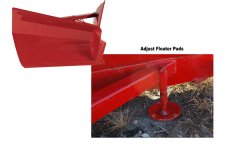Anybody else having this problem?
Snow clearing with a V blade , new machine, first day out hit a manhole cover and slightly bent/twisted the lifting arm(s)
We're able to straighten them in the shop by chaining down the oposite side of the yoke and lifting with the overhead crane, the whole machine lifted so we also chained the machine down and that did it.
However the next day a small clip of another lip edge of a submerged item re-twisted the arm.
Are these arms weak and/or under designed? It looks that when the arms are down and the plow is in the working position that the rotational force to failure would be easy to achieve, same problem when scraping with a bucket.
Is thier a Bobcat technician out there that dares offer an opinion?
The arms could be designed to be much wider apart allowing the 'twisting" motion at the bottom of their arc to be less likly to cause this problem, something like the rest of the skid-steer loaders.
I'm curious if others are suffering this issue.
Snow clearing with a V blade , new machine, first day out hit a manhole cover and slightly bent/twisted the lifting arm(s)
We're able to straighten them in the shop by chaining down the oposite side of the yoke and lifting with the overhead crane, the whole machine lifted so we also chained the machine down and that did it.
However the next day a small clip of another lip edge of a submerged item re-twisted the arm.
Are these arms weak and/or under designed? It looks that when the arms are down and the plow is in the working position that the rotational force to failure would be easy to achieve, same problem when scraping with a bucket.
Is thier a Bobcat technician out there that dares offer an opinion?
The arms could be designed to be much wider apart allowing the 'twisting" motion at the bottom of their arc to be less likly to cause this problem, something like the rest of the skid-steer loaders.
I'm curious if others are suffering this issue.

